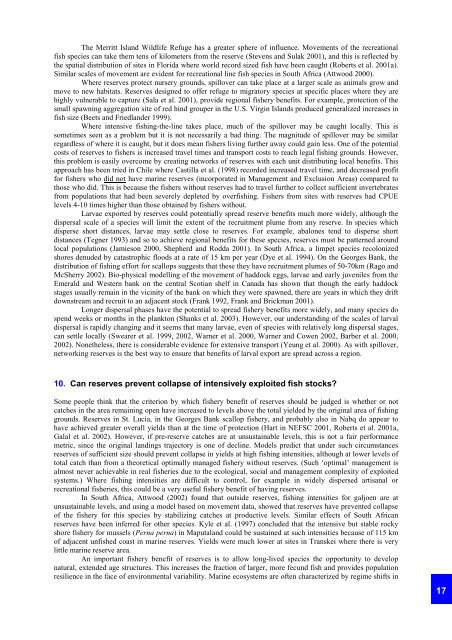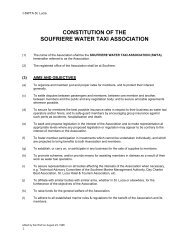WWF Cover photo - Soufriere Marine Management Association ...
WWF Cover photo - Soufriere Marine Management Association ...
WWF Cover photo - Soufriere Marine Management Association ...
You also want an ePaper? Increase the reach of your titles
YUMPU automatically turns print PDFs into web optimized ePapers that Google loves.
The Merritt Island Wildlife Refuge has a greater sphere of influence. Movements of the recreationalfish species can take them tens of kilometers from the reserve (Stevens and Sulak 2001), and this is reflected bythe spatial distribution of sites in Florida where world record sized fish have been caught (Roberts et al. 2001a).Similar scales of movement are evident for recreational line fish species in South Africa (Attwood 2000).Where reserves protect nursery grounds, spillover can take place at a larger scale as animals grow andmove to new habitats. Reserves designed to offer refuge to migratory species at specific places where they arehighly vulnerable to capture (Sala et al. 2001), provide regional fishery benefits. For example, protection of thesmall spawning aggregation site of red hind grouper in the U.S. Virgin Islands produced generalized increases infish size (Beets and Friedlander 1999).Where intensive fishing-the-line takes place, much of the spillover may be caught locally. This issometimes seen as a problem but it is not necessarily a bad thing. The magnitude of spillover may be similarregardless of where it is caught, but it does mean fishers living further away could gain less. One of the potentialcosts of reserves to fishers is increased travel times and transport costs to reach legal fishing grounds. However,this problem is easily overcome by creating networks of reserves with each unit distributing local benefits. Thisapproach has been tried in Chile where Castilla et al. (1998) recorded increased travel time, and decreased profitfor fishers who did not have marine reserves (incorporated in <strong>Management</strong> and Exclusion Areas) compared tothose who did. This is because the fishers without reserves had to travel further to collect sufficient invertebratesfrom populations that had been severely depleted by overfishing. Fishers from sites with reserves had CPUElevels 4-10 times higher than those obtained by fishers without.Larvae exported by reserves could potentially spread reserve benefits much more widely, although thedispersal scale of a species will limit the extent of the recruitment plume from any reserve. In species whichdisperse short distances, larvae may settle close to reserves. For example, abalones tend to disperse shortdistances (Tegner 1993) and so to achieve regional benefits for these species, reserves must be patterned aroundlocal populations (Jamieson 2000, Shepherd and Rodda 2001). In South Africa, a limpet species recolonizedshores denuded by catastrophic floods at a rate of 15 km per year (Dye et al. 1994). On the Georges Bank, thedistribution of fishing effort for scallops suggests that these they have recruitment plumes of 50-70km (Rago andMcSherry 2002). Bio-physical modelling of the movement of haddock eggs, larvae and early juveniles from theEmerald and Western bank on the central Scotian shelf in Canada has shown that though the early haddockstages usually remain in the vicinity of the bank on which they were spawned, there are years in which they driftdownstream and recruit to an adjacent stock (Frank 1992, Frank and Brickman 2001).Longer dispersal phases have the potential to spread fishery benefits more widely, and many species dospend weeks or months in the plankton (Shanks et al. 2003). However, our understanding of the scales of larvaldispersal is rapidly changing and it seems that many larvae, even of species with relatively long dispersal stages,can settle locally (Swearer et al. 1999, 2002, Warner et al. 2000, Warner and Cowen 2002, Barber et al. 2000,2002). Nonetheless, there is considerable evidence for extensive transport (Yeung et al. 2000). As with spillover,networking reserves is the best way to ensure that benefits of larval export are spread across a region.10. Can reserves prevent collapse of intensively exploited fish stocks?Some people think that the criterion by which fishery benefit of reserves should be judged is whether or notcatches in the area remaining open have increased to levels above the total yielded by the original area of fishinggrounds. Reserves in St. Lucia, in the Georges Bank scallop fishery, and probably also in Nabq do appear tohave achieved greater overall yields than at the time of protection (Hart in NEFSC 2001, Roberts et al. 2001a,Galal et al. 2002). However, if pre-reserve catches are at unsustainable levels, this is not a fair performancemetric, since the original landings trajectory is one of decline. Models predict that under such circumstancesreserves of sufficient size should prevent collapse in yields at high fishing intensities, although at lower levels oftotal catch than from a theoretical optimally managed fishery without reserves. (Such ‘optimal’ management isalmost never achievable in real fisheries due to the ecological, social and management complexity of exploitedsystems.) Where fishing intensities are difficult to control, for example in widely dispersed artisanal orrecreational fisheries, this could be a very useful fishery benefit of having reserves.In South Africa, Attwood (2002) found that outside reserves, fishing intensities for galjoen are atunsustainable levels, and using a model based on movement data, showed that reserves have prevented collapseof the fishery for this species by stabilizing catches at productive levels. Similar effects of South Africanreserves have been inferred for other species. Kyle et al. (1997) concluded that the intensive but stable rockyshore fishery for mussels (Perna perna) in Maputaland could be sustained at such intensities because of 115 kmof adjacent unfished coast in marine reserves. Yields were much lower at sites in Transkei where there is verylittle marine reserve area.An important fishery benefit of reserves is to allow long-lived species the opportunity to developnatural, extended age structures. This increases the fraction of larger, more fecund fish and provides populationresilience in the face of environmental variability. <strong>Marine</strong> ecosystems are often characterized by regime shifts in17



